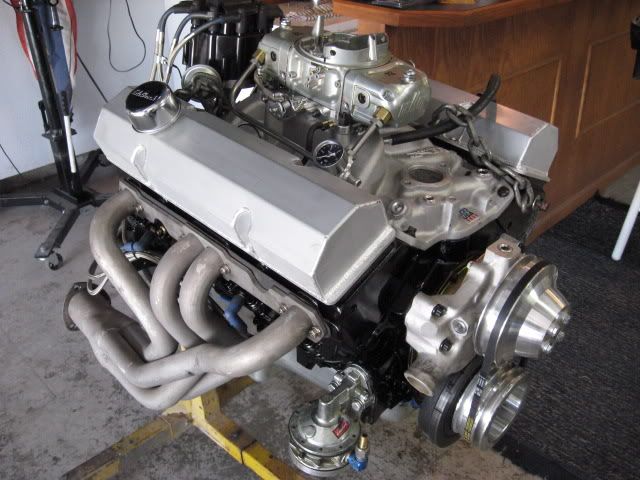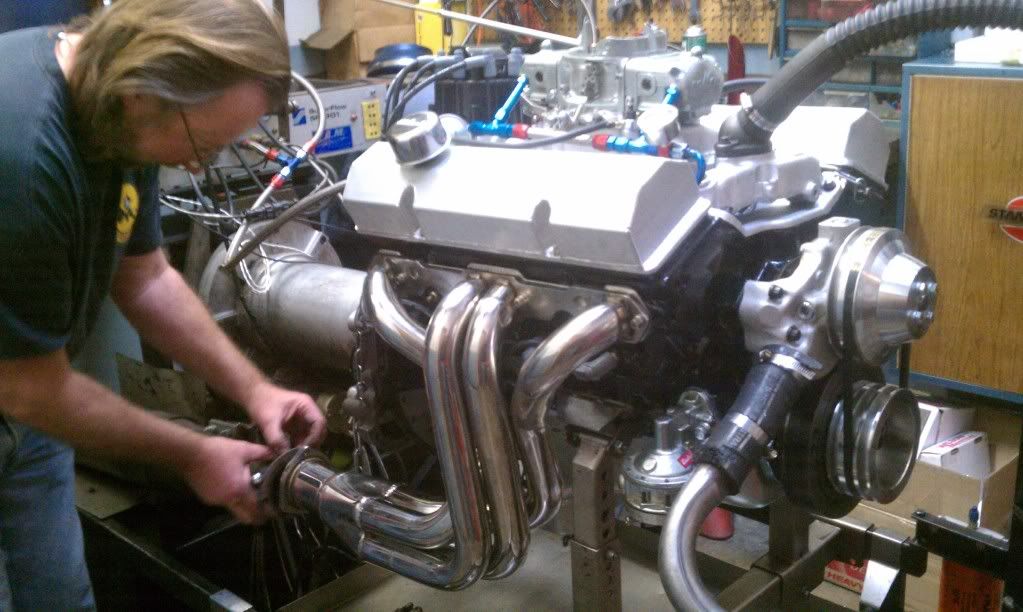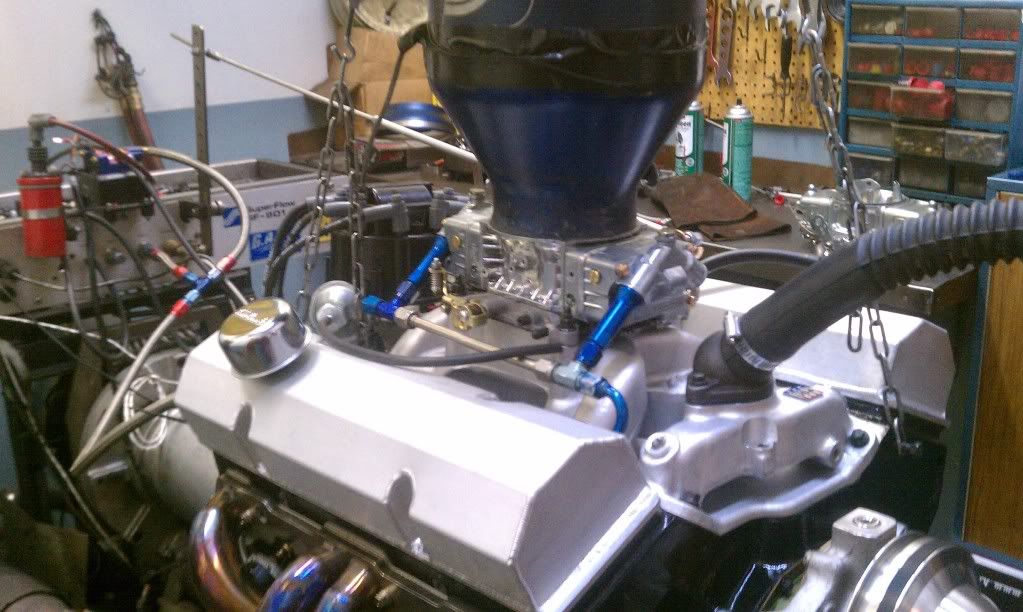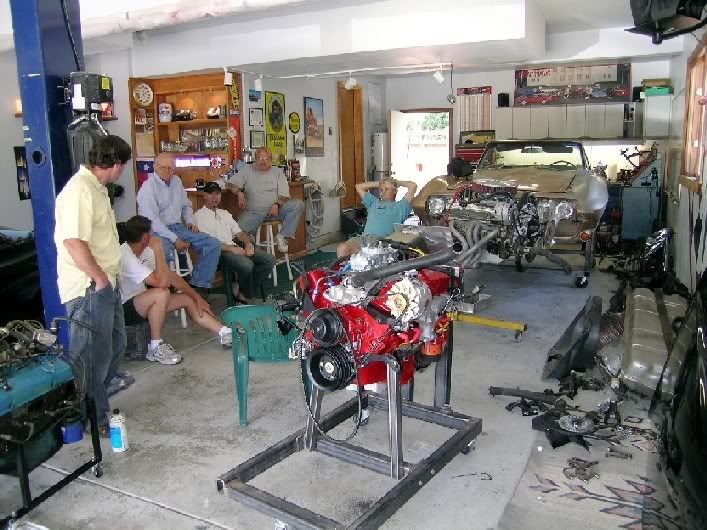lars
Well-known member
- Joined
- Feb 15, 2003
- Messages
- 209
- Location
- In my workshop bar in Denver
- Corvette
- 64 Black Roadster; 85 Coupe; 09 G8 GT 4-door Vette
We took the 383 Small Block (see previous thread http://www.corvetteactioncenter.com/forums/c3-technical-performance/125743-383-dyno-results.html ) back to the dyno Friday to see if there was a little more horsepower to get out of it using a new mix of parts…
Previous dyno results indicated that the little Edelbrock Performer EPS manifold might be holding this thing back (we chose the EPS Performer to make it fit under a ‘Vette hood). The numbers off the last dyno run also indicated that this modest engine actually wanted a bigger set of headers: When we switched from a set of 1-5/8” headers to a giant set of 1-7/8” headers (loaned to me by the dyno operator), power jumped from 399 to 407 horsepower. Time to check and validate all this… (what the heck – money is no object, right?)
To establish a comparable baseline to a known previous dyno run, the small 1-5/8” headers were re-installed on the engine along with an Edelbrock Performer RPM Airgap intake: This would allow us to make a direct comparison of the Airgap to the EPS with no other changes to the engine.
The base configuration: Edelbrock EPS intake, BG Speed Demon 750, and 1-5/8” headers:

Here are the baseline numbers for comparison from the previous dyno run with the small headers and the EPS intake:
Baseline:
EPS Intake, 1-5/8" Headers
Torque HP
RPM
2500 399 190
3000 410 234
3500 436 291
4000 435 331
4500 440 377
5000 409 399
5500 379 397
BEST 445.5 399
NOTE: The “BEST” numbers do not necessarily correspond to one of the 500 rpm increments shown on the charts here. I pulled the “BEST” numbers off the dyno results sheets, and those numbers may not show up on my abbreviated charts that I am presenting here (to prevent me from acquiring Carpal Tunnel from typing in all the numbers). Just want you to know I’m not fudging the numbers…
The first pull showed the manifold change to have leaned out the mixture by a full point. I bumped jetting by 4 sizes front and rear (on the BG Speed Demon 750 carb) and did another pull. The A/F now duplicated the A/F on the "baseline" run with the EPS manifold, but power numbers dropped from the first pull. The indication is that the Airgap manifold is a bit more efficient than the EPS, and the engine wants a leaner mixture. Jetting was dropped 2 sizes, and the best numbers were achieved. The change from the EPS to the Airgap was worth 10 hp with insignificant loss of torque below 3500 rpm. Note to self: When swapping from a stock-style 4-barrel manifold to an Airgap RPM, increase jet sizes 2 sizes front and rear to maintain proper mixture (assuming mixture is correct prior to the manifold swap).
RPM Airgap, 1-5/8" Headers
Torque HP
RPM
2500
3000 397 227
3500 432 288
4000 436 332
4500 440 377
5000 422 402
5500 391 409
BEST 444 409
We then installed a Wilson 1-1/2" Tapered Spacer – these things are the hot ticket, and the spacer is a work of art. This, again, caused a lean condition, so the jetting was corrected to obtain comparative data. Once jetting was corrected to obtain peak power numbers, the numbers virtually duplicated the numbers without the spacer - the spacer made no significant change other than a slight loss of torque below 3500. Peak numbers were essentially unchanged.
w/Wilson 1.5" Tapered
Torque HP
RPM
2500 368 175
3000 404 231
3500 421 281
4000 437 333
4500 440 377
5000 423 403
5500 390 408
BEST 443 410
A switch to a 1” BG Combo Spacer produced the same results - no real change in numbers.
w/BG 1" Combo Spacer
Torque HP
RPM
2500 380 181
3000 404 231
3500 420 280
4000 427 326
4500 441 378
5000 422 402
5500 393 411
BEST 443 412
This is indicative that the RPM Airgap intake manifold has adequate plenum volume, and that the manifold is a pretty darned good design for the rpm range of this street engine. It is likely that the spacers would have shown a gain in power above 6,000 rpm with little or no loss of torque on the low end, but this street engine isn’t operating in the rpm range needed for the spacers to become effective.
The spacer was then removed, and we removed the 1-5/8" headers in favor of the 1-7/8" headers. If you believe all the junk you read on the Internet, you “know” that big headers don’t work on small engines – especially at high altitude (I’m at 5,500 feet elevation). So I wanted to see if the power increase we obtained during the first testing could be duplicated with another set of big-tube headers. Without needing any jetting change, the power number jumped from 409 to 422 - a 13 hp increase with insignificant loss of torque at low rpm. This not only duplicated, but was better than, the results from the previous testing and validated the fact that this engine likes the big headers – even though operating below 6,000 rpm. The headers we used are from a relatively new manufacturer: XS Power. These are the best-looking stainless steel headers I have seen, featuring thick flanges, perfect bends, and excellent quality welds. Even if you don’t want the power these headers offer and just want the cosmetic show of these outstanding quality units, these things are the way to go. But fact is, they work as good as they look – they’re worth 13 horsepower over the “other guys’ headers” in the rpm range that counts. And we beat the crap out of these headers with the testing, and had them glowing bright cherry red. The photo shows me installing them while they were nice and shiny silver…. They’re now dark blue…
1-7/8" Headers, no spcr
Torque HP
RPM
2500 403 192
3000 374 213
3500 440 294
4000 433 330
4500 436 374
5000 429 409
5500 402 421
BEST 447 422
Installing the XS Power 1-7/8” headers on the engine:

Since we had been testing with a BG Speed Demon Carb, which is no longer available after BG went under, we then swapped over to a Holley 750 HP Street Carb (Holley carb and Wilson/BG spacers on loan to me courtesy of Ole’s Carburetor & Electric, 120 El Camino Real, San Bruno CA 94066 650-589-7377). The Holley HP duplicated the BG A/F numbers (BG carb was 2 sizes richer than stock, which was duplicated by the HP out-of-the-box configuration – good jetting by Holley). The HP duplicated the BG pull within 0.3hp across the entire rpm range. It’s the closest pull between two different components that I have ever seen. It's as if no change at all had been made - the results were absolutely identical to the BG carb. Point here, that I have always advocated on this Forum: Run the carb you are most comfortable with and tune it well. Any of the good quality carbs (which does not include the Edelbrock “Performer”) of similar size can be tuned and set up to run as well as any other carb. This Holley HP, in terms of performance, is a dead ringer for the BG Speed Demon – good to know now that BG is out of business and no longer producing carbs. I have been a big fan of the BG products, but I would now advocate this HP-Series carb as an excellent street performance carb for use with a square-bore intake manifold.
Holley 750 HP Street on the dyno. Looks like those headers got hot during the previous test...

I then re-installed the BG carb without a spacer.
The final "Banzai run" was done with an oil change from straight 30w to Mobil1 5w30. This produced final peak numbers of 425 hp.
In all, we did no less than 18 dyno pulls on the engine this time (in addition to all the pulls we did the first time), validating and duplicating each pull with a backup pull to make sure the numbers are repeatable and not bogus flukes. The data presented here is real and repeatable: we darned near wore out this poor guy’s engine proving it. I might have to rebuild it for him now…
The heavy, dual valve springs and spring retainers on this engine seemed to limit high-rpm potential somewhat, so we're now swapping over to a set of Beehive springs with the small retainers. This will shave about 20 grams off the weight of the valve assembly, and should allow another 200 rpm before the power starts dropping off – this should be a fun engine in a 4-speed Vette…
No, we're not going back on the dyno to validate the Beehive springs’ rpm potential…
Lars
Previous dyno results indicated that the little Edelbrock Performer EPS manifold might be holding this thing back (we chose the EPS Performer to make it fit under a ‘Vette hood). The numbers off the last dyno run also indicated that this modest engine actually wanted a bigger set of headers: When we switched from a set of 1-5/8” headers to a giant set of 1-7/8” headers (loaned to me by the dyno operator), power jumped from 399 to 407 horsepower. Time to check and validate all this… (what the heck – money is no object, right?)
To establish a comparable baseline to a known previous dyno run, the small 1-5/8” headers were re-installed on the engine along with an Edelbrock Performer RPM Airgap intake: This would allow us to make a direct comparison of the Airgap to the EPS with no other changes to the engine.
The base configuration: Edelbrock EPS intake, BG Speed Demon 750, and 1-5/8” headers:

Here are the baseline numbers for comparison from the previous dyno run with the small headers and the EPS intake:
Baseline:
EPS Intake, 1-5/8" Headers
Torque HP
RPM
2500 399 190
3000 410 234
3500 436 291
4000 435 331
4500 440 377
5000 409 399
5500 379 397
BEST 445.5 399
NOTE: The “BEST” numbers do not necessarily correspond to one of the 500 rpm increments shown on the charts here. I pulled the “BEST” numbers off the dyno results sheets, and those numbers may not show up on my abbreviated charts that I am presenting here (to prevent me from acquiring Carpal Tunnel from typing in all the numbers). Just want you to know I’m not fudging the numbers…
The first pull showed the manifold change to have leaned out the mixture by a full point. I bumped jetting by 4 sizes front and rear (on the BG Speed Demon 750 carb) and did another pull. The A/F now duplicated the A/F on the "baseline" run with the EPS manifold, but power numbers dropped from the first pull. The indication is that the Airgap manifold is a bit more efficient than the EPS, and the engine wants a leaner mixture. Jetting was dropped 2 sizes, and the best numbers were achieved. The change from the EPS to the Airgap was worth 10 hp with insignificant loss of torque below 3500 rpm. Note to self: When swapping from a stock-style 4-barrel manifold to an Airgap RPM, increase jet sizes 2 sizes front and rear to maintain proper mixture (assuming mixture is correct prior to the manifold swap).
RPM Airgap, 1-5/8" Headers
Torque HP
RPM
2500
3000 397 227
3500 432 288
4000 436 332
4500 440 377
5000 422 402
5500 391 409
BEST 444 409
We then installed a Wilson 1-1/2" Tapered Spacer – these things are the hot ticket, and the spacer is a work of art. This, again, caused a lean condition, so the jetting was corrected to obtain comparative data. Once jetting was corrected to obtain peak power numbers, the numbers virtually duplicated the numbers without the spacer - the spacer made no significant change other than a slight loss of torque below 3500. Peak numbers were essentially unchanged.
w/Wilson 1.5" Tapered
Torque HP
RPM
2500 368 175
3000 404 231
3500 421 281
4000 437 333
4500 440 377
5000 423 403
5500 390 408
BEST 443 410
A switch to a 1” BG Combo Spacer produced the same results - no real change in numbers.
w/BG 1" Combo Spacer
Torque HP
RPM
2500 380 181
3000 404 231
3500 420 280
4000 427 326
4500 441 378
5000 422 402
5500 393 411
BEST 443 412
This is indicative that the RPM Airgap intake manifold has adequate plenum volume, and that the manifold is a pretty darned good design for the rpm range of this street engine. It is likely that the spacers would have shown a gain in power above 6,000 rpm with little or no loss of torque on the low end, but this street engine isn’t operating in the rpm range needed for the spacers to become effective.
The spacer was then removed, and we removed the 1-5/8" headers in favor of the 1-7/8" headers. If you believe all the junk you read on the Internet, you “know” that big headers don’t work on small engines – especially at high altitude (I’m at 5,500 feet elevation). So I wanted to see if the power increase we obtained during the first testing could be duplicated with another set of big-tube headers. Without needing any jetting change, the power number jumped from 409 to 422 - a 13 hp increase with insignificant loss of torque at low rpm. This not only duplicated, but was better than, the results from the previous testing and validated the fact that this engine likes the big headers – even though operating below 6,000 rpm. The headers we used are from a relatively new manufacturer: XS Power. These are the best-looking stainless steel headers I have seen, featuring thick flanges, perfect bends, and excellent quality welds. Even if you don’t want the power these headers offer and just want the cosmetic show of these outstanding quality units, these things are the way to go. But fact is, they work as good as they look – they’re worth 13 horsepower over the “other guys’ headers” in the rpm range that counts. And we beat the crap out of these headers with the testing, and had them glowing bright cherry red. The photo shows me installing them while they were nice and shiny silver…. They’re now dark blue…
1-7/8" Headers, no spcr
Torque HP
RPM
2500 403 192
3000 374 213
3500 440 294
4000 433 330
4500 436 374
5000 429 409
5500 402 421
BEST 447 422
Installing the XS Power 1-7/8” headers on the engine:

Since we had been testing with a BG Speed Demon Carb, which is no longer available after BG went under, we then swapped over to a Holley 750 HP Street Carb (Holley carb and Wilson/BG spacers on loan to me courtesy of Ole’s Carburetor & Electric, 120 El Camino Real, San Bruno CA 94066 650-589-7377). The Holley HP duplicated the BG A/F numbers (BG carb was 2 sizes richer than stock, which was duplicated by the HP out-of-the-box configuration – good jetting by Holley). The HP duplicated the BG pull within 0.3hp across the entire rpm range. It’s the closest pull between two different components that I have ever seen. It's as if no change at all had been made - the results were absolutely identical to the BG carb. Point here, that I have always advocated on this Forum: Run the carb you are most comfortable with and tune it well. Any of the good quality carbs (which does not include the Edelbrock “Performer”) of similar size can be tuned and set up to run as well as any other carb. This Holley HP, in terms of performance, is a dead ringer for the BG Speed Demon – good to know now that BG is out of business and no longer producing carbs. I have been a big fan of the BG products, but I would now advocate this HP-Series carb as an excellent street performance carb for use with a square-bore intake manifold.
Holley 750 HP Street on the dyno. Looks like those headers got hot during the previous test...

I then re-installed the BG carb without a spacer.
The final "Banzai run" was done with an oil change from straight 30w to Mobil1 5w30. This produced final peak numbers of 425 hp.
In all, we did no less than 18 dyno pulls on the engine this time (in addition to all the pulls we did the first time), validating and duplicating each pull with a backup pull to make sure the numbers are repeatable and not bogus flukes. The data presented here is real and repeatable: we darned near wore out this poor guy’s engine proving it. I might have to rebuild it for him now…
The heavy, dual valve springs and spring retainers on this engine seemed to limit high-rpm potential somewhat, so we're now swapping over to a set of Beehive springs with the small retainers. This will shave about 20 grams off the weight of the valve assembly, and should allow another 200 rpm before the power starts dropping off – this should be a fun engine in a 4-speed Vette…
No, we're not going back on the dyno to validate the Beehive springs’ rpm potential…
Lars







